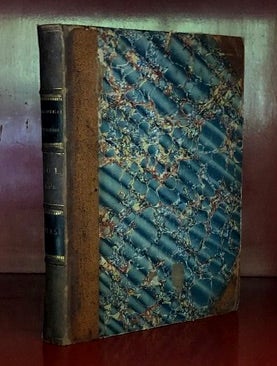On a case of superficial colour presented by a homogeneous liquid internally colourless (Herschel, pp. 143-145) & On the epip lic dispersion of light, being a supplement to a paper entitled, On a case of superficial colour presented by a homogeneous liquid internally colourless (Herschel, pp. 147-153) WITH On the Liquefaction and Solidification of Bodies Generally Existing as Gases (Faraday, pp. 155-179) WITH On the Gas Voltaic Battery. Voltaic Action of Phosphorus, Sulphur and Hydrocarbons (Grove, pp. 351-361) WITH Electro-Physiological Researches. 1st, 2nd, & 3rd Memoir (Matteucci, pp. 283-319) in Philosophical Transactions of the Royal Society of London, Volume 135, 1845
London: The Royal Society, 1845. 1st Edition. BOUND 1st EDITION OF AN IMPRESSIVE COMPILATION OF 1845 PAPERS, among them significant papers by JW Herschel, Michael Faraday, W.R. Grove, and Carlo Matteucci.
HERSCHEL’S PAPERS present “the 'modern' milestone for observing fluorescence” (Heinrichs, Milestones, Nature RMCB, 2009). In them he notes “that a quinine solution, although itself colorless and transparent, exhibits a ‘vivid and beautiful celestial blue color’ when illuminated and observed under certain incidences of sunlight”; Renz, Fluoresence, Cytometry, 2013). “This is the first reported observation of fluorescence” and it has been “particularly important to the future of science (Molecular Expressions, FSU; Renz).
“Herschel recognized the presence of an unusual phenomenon which could not be explained by the scientific knowledge of the time. To this day, the fluorescence of quinine remains one of the most used and most beautiful examples of fluorescence” (Lakowicz, Fluoresence, 2). He called the phenomenon and its dispersion of light ‘epipolic dispersion’ which Stokes later replaced ‘fluorescence’” (Buttman, The Shadow of the Telescope, 167).
FARADAY’S PAPER: Known as “the 1845 paper” it “is famous for its conjecture that gases could not be liquefied at temperatures above their critical point, no matter what the pressure. Faraday seems to be the first to make this conjecture linking gas liquefaction with the critical point. The paper illustrates the attribute of Faraday as an unrivaled technician… The net result of this study was that about a half dozen compounds were solidified and another half-dozen compounds liquefied for the first time. For the first time vapor pressures as a function of temperature for temperatures well below freezing were obtained for compounds which were gases at ambient temperatures. It can be argued that these were the first cryogenic measurements” (Gentry, The Role of Michael Faraday in the Development of Contemporary Chemical Engineering, ASEE 1996 Conference).
GROVE’S PAPER: The first hydrogen-oxygen cell (fuel cell) was demonstrated by William Grove in 1839. “While investigating the electrolysis of water, Grove observed that when the current was switched off, a small current flowed through the circuit in the opposite direction, as a result of a reaction between the electrolysis products, hydrogen and oxygen, catalyzed by the platinum electrodes. [He] recognized the possibility of combining several of these in series to form a gaseous voltaic battery, also [making] the crucially important observation that there must be a ‘notable surface of action’ between the gas, the electrolyte, and the electrode phases in a cell” (Stolten, Fuel Cells, 63). Subsequent experiments stimulated the idea that his “battery establishes that gases in combining and acquiring a liquid form evolve sufficient force to decompose a similar liquid and cause it to acquire a gaseous form” (DSB, V, pp. 559-560).
In 1845 and in this paper, “Grove presented the results of [his subsequent] experiments and introduced the gas voltaic battery as an instrument to test for vaporization… He then described a new form of gas battery that could accommodate an indefinite number of cells, using hydrogen from zinc and oxygen from the air” (Fuel Cell Technology, Gaseous Voltaic Battery). “This battery establishes that gases in combining and acquiring a liquid form evolve sufficient force to decompose a similar liquid and cause it to acquire a gaseous form. This is to my mind the most interesting effect of the battery; it exhibits such a beautiful instance of the correlation of natural forces” (DSB).
MATTUCCI’S PAPER presents his "frog battery" constructed from 12 to 14 half-thighs of frogs. Item #1260
CONDITION: Complete. 6 plates. Faded stamp & blind stamp on title page; no other markings. Half-calf over marbled paper boards with minor scuffing; black gilt-lettered spine labels. Original wide margins; slight spotting to endpapers. Near fine.
Price: $500.00

